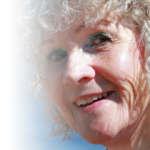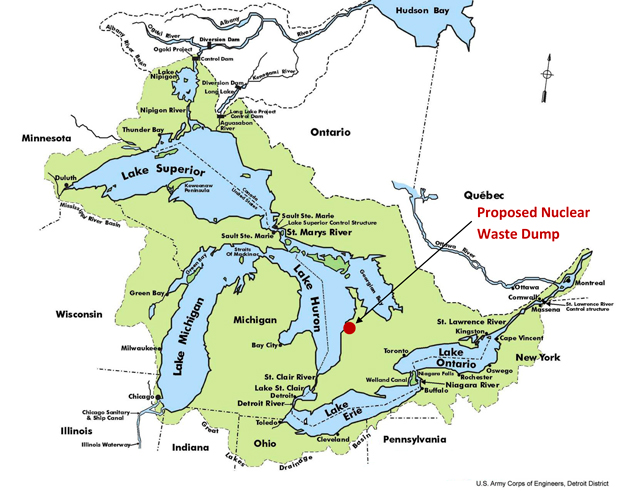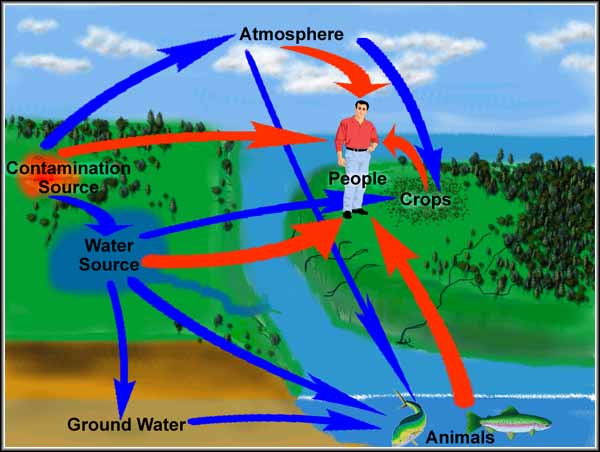 Never before in my life have I been in such close proximity to the workings of Canada’s governing institutions. This witnessing recently took place at a month-long public hearing held by the Canadian Environmental Assessment Agency (CEAA), in Bruce County, Ontario. The focus is a proposed deep geologic repository (DGR) for low and intermediate radioactive waste, to be located a bit more than a kilometre from the (current) shoreline of Lake Huron. This lake is within the Great Lakes/St. Lawrence River Basin, one of the last large basins of fresh water on the planet, and source to drinking water for an estimated 40 million people in Canada and the United States.
Never before in my life have I been in such close proximity to the workings of Canada’s governing institutions. This witnessing recently took place at a month-long public hearing held by the Canadian Environmental Assessment Agency (CEAA), in Bruce County, Ontario. The focus is a proposed deep geologic repository (DGR) for low and intermediate radioactive waste, to be located a bit more than a kilometre from the (current) shoreline of Lake Huron. This lake is within the Great Lakes/St. Lawrence River Basin, one of the last large basins of fresh water on the planet, and source to drinking water for an estimated 40 million people in Canada and the United States.
Every day from mid-September to Thanksgiving I attended this hearing. Following my own 30-minute presentation in the first week, most of my waking hours not spent at the hearing were devoted to further research and preparation to ask questions, when suitable, after other presentations.
More than a hundred interveners gave oral presentations of either 10 or 30 minutes in length. The three-person Joint Review Panel (JRP) then would interrogate the presenters, to gather evidence from all parties speaking in favour of, or against, the proposed DGR. All parties included Ontario Power Generation, Inc. (OPG), the Canadian Nuclear Safety Commission (CNSC), and registered members of the public.
Following each JRP interrogation, further questions were allowed from registered public participants. Written submissions by other citizens, Canadian and American, who could not attend, also were read into the public record.
My own presentation made the case that the environmental guidelines themselves were flawed. I also critiqued methods of scientific inquiry, such as computer modelling, as inadequate to understand fully how living organisms function, let alone properly measure the impacts of radioactive contamination.
In other words, the science is not there – if it ever could be – for human beings to assume that we know sufficiently how to bury materials, that contain ionizing radiation, and be able to ensure reasonable safety to human and environmental life. The uncertainties are too many.
Other presenters later criticized the ways that Ontario Power Generation, Inc. (OPG) did not even meet the guidelines, in its proposal to construct a DGR, using a shaft design that only is in a conceptual stage. The OPG’s report also fell short on several aspects of its environmental research, because of major gaps of information, on top of the uncertainties.
The facts exposed during this public hearing were unbelievable, resembling a `theatre of the absurd.’ The very idea of burying radioactive waste so close to a major lake system boggles the mind. Where do I begin?
The `proponent” here refers to Ontario Power Generation, Inc. (OPG), which owns the land occupied by Bruce Power and the site where the DGR is proposed. The OPG also owns other Ontario nuclear generating station sites, from which low and intermediate radioactive waste would be delivered, as well, to this proposed DGR beside Lake Huron.
The OPG works in liaison with the Nuclear Waste Management Organization (NWMO). But that fact repeatedly has been put aside by the JRP, to the chagrin of those of us who are local citizens. For we know too well the current political manoeuvrings by the NWMO in our municipalities to promote a second DGR, for high level radioactive waste.
JRP’s insistence to stick with their original `Terms of Reference,’ whether reluctantly or not, indicates one of the fundamental flaws in the regulatory process. It obligates the panel to focus only on the proposal to bury low and intermediate waste, as the terms originally described it.
What is worrisome, meanwhile, is how the proposed DGR project, for which the panel members signed on to adjudicate a public hearing, has shape-shifted more recently into a different project.
OPG now wants to add `decommissioning’ radioactive waste to this proposed DGR, which could increase its size two-fold or more, with interrelated consequences on the engineering design (i.e. size) and all aspects of the environment – terrestrial, aquatic and underground pathways. Aside from volume, the proportions between low and intermediate waste would be altered, hence, as well the eventual `cumulative effects,’ the latter which OPG has sorely underestimated.
Indeed, even as the panel circumscribes the public hearing to its original mandate and the initially proposed DGR, the unknown factors are many. They range from still unknown effects of various radionuclides on entire ecosystems, potential of water seepage, questionable robustness of shaft seals and more, to the inevitable upcoming extreme weather events and climate change that will disrupt the geology.
Meaningful predictions are humanly impossible, yet OPG and NWMO stubbornly – and arrogantly – persist in making them. Despite repeated criticisms about their research, they kept to their original script that there will be “no significant adverse effects.”
The panel members are not fools. Even though they are constrained by the original DGR proposal, to their credit they have been relentlessly questioning the obvious lack of rigour in the research delivered by the OPG/NWMO to the regulator, which is the Canadian Nuclear Safety Commission (CNSC). The panel, moreover, has questioned the CNSC about why it gave certain approvals.
The OPG’s report to justify its proposed DGR, produced as an Environmental Impact Statement (EIS), must meet the approval of the CNSC, which is a federal government agency. This EIS also must meet the regulations of several other government ministries. These are the players, together with municipal politicians in Bruce County, who provide the back story in a democratic process that has been a sham up to this current public hearing process.
For the wider public – not just local citizens in Bruce County – but as well folks farther afield all the way south to include our American “cousins” – most particularly in Michigan – were not decently consulted about this proposed DGR. A number of local, and American, interveners provided that evidence.
Two among several of the American interveners, in fact, included Senator Hoon-Yung Hopgood and Michigan State Representative Sarah Roberts, who verified the lack of inclusion in public consultations, and lack of awareness among their citizens, until recent months.
Throughout the public hearing I had a heavy heart in looking at too many empty chairs. For a while, I thought, must we always wait for major disasters before people wake up to stop further violation to the earth? But then, compassionately, I recognized the fuller truth of apparent disinterest is a lot more complicated.
Living in Bruce County for seven years, I recognize that it is too easy to accuse folks of indifference. Instead, the empty seats symbolize the dark, hidden side of a rural region, in a struggling global economy, in which a visible portion of the population have grown to perceive a dependence on a single industry. Doing so, I would argue, is more a convenient mental construct than the actual reality.
In this case, the major single employer is the nuclear industry, signified by Bruce Power, said to be the largest nuclear generating station in the world. Through the several decades that it has entrenched its foothold in this region, the more inclusive economic vision – that encompasses a significant agricultural community as well as a strong tourism legacy – appears to be getting side-lined by the political and corporate power-holders whose vision is more one-dimensional and self-serving.
The result is, many citizens feel muzzled, by fear of losing jobs or losing the business of highly-paid workers at the power plant and its related facility, the Western Waste Management Facility (WWMF), where the low and intermediate level waste has been stored safely for 40 years or more.
Another big question that is surfacing is, how much do Bruce Power workers feel silenced if and when they and, in turn, family members, contract life-threatening illnesses from undetected radiation poisoning. Local health studies are shamefully lacking.
Also largely silenced is the farming community, collectively feeling the government pays no heed to their voices. Yet, perhaps more than any other moment on this planet, we need to retain, and protect, sustainable agricultural land, and clean water, in a world that is heading towards a water and food crisis.
The Municipality of Kincardine is the primary community that would benefit the most, economically, because close to half, maybe more, of its residents are employed at Bruce Power, and the DGR is proposed to be built next to it. The selfishness of certain Town of Kincardine residents that spoke, in their presentations, to how wonderful the economic benefits are – for them – must be challenged.
I remind myself that what I am witnessing is a microcosm of the human condition, in which there are the self-serving `haves’ willfully oblivious to the ripple effects upon the `have-nots.’ The former make troubling choices to enhance their own economic gain, with no consideration for the larger human and environmental costs now and in the future.
Humans can continue to create and develop diverse forms of energy production. But once the water and the soil get contaminated, the sources that sustain life are gone, forever.
Three farming families presented well-informed views at the public hearing. They spoke out about the risks and dangers which the OPG/NWMO consistently minimized in their thousands of pages of research.
Very important to acknowledge – even emphasize – are the outstanding presentations by concerned citizens. The above farmers, among other intrepid individuals from many walks of life, chose to educate themselves and take responsibility to engage proactively in `participatory democracy,’ to stand up for what really matters – valuing and protecting life.
Indeed, beautiful to behold in the formal, regimented space of a public hearing have been the soulfully powerful voices of ordinary citizens not just “using” but, moreover, “reinforcing” the democratic process by making sure their voices are being heard.
In doing so, such individuals, who come together from neighbouring communities, as truth tellers, have exposed what is politically unethical, corporately manipulative, and environmentally not acceptable about the whole trajectory of this DGR project to date.
Also important to acknowledge are the professional experts who have dedicated their lives to various fields such as engineering, ecology, biology, law and human health. They travelled long distances to share their knowledge and concerns about the dangers of burying radioactive waste so deeply underground.
Ed Burt, the eldest presenter at age 85, gifted us with a 30-minute presentation that was magnificent. The reason is, he spoke from a place of love, as a gifted storyteller who offered the long view. Working on the land, Mr. Burt also has dedicated his life to raising nuclear awareness. I told his wife that I wish our Euro-western culture could honour elders and storytellers, like her husband, in the ways that Indigenous cultures do.
Indeed, further life-affirming about the public hearing process was to sit together with Aboriginal people. Our closest neighbours are the Saugeen Ojibway Nation (SON). Its eloquent spokesperson at the hearing is Chief Randall Kahgee who, with his astute legal counsel, spelled out what really matters.
The spiritual integrity of our shared concern for the earth, and the children yet unborn, is creating a major step forward in cross-cultural healing.
Last, but not least, were the voices of youth. In separate 30-minute presentations, Caitlin McAllister and Hana Splettstoesser, both secondary school students, expressed very articulate messages to remind us again that it is their generation and the generations to come that will inherit the outcomes of whatever gets decided.
For me, what links Mr. Burt, Chief Kahgee, and Misses McAllister and Splettstoesser in importance is their implicit recognition of the `sacred feminine,’ a running theme in my blog writings. The sacred feminine is the life force within everything alive, energetically connecting our spirit with the earth, and why human consciousness needs to evolve to heal and strengthen that reconnection as a species.
Standing together, as biological and spiritual beings, simple caring has helped us discover the best of who we can be, and perhaps awakened inner resources of strength in some of us previously untapped. Most of us took on a daunting task without funds, sacrificing much time through many months of our lives, to present scientific and spiritual insights that have been treated respectfully by the Joint Review Panel. Our work is not yet done.
As for the supporters of the proposed DGR who live in Kincardine, and Saugeen Shores next door, they simply put human faces onto the folly of what the larger North American society, so attached to its comforts, has been seduced into believing through the past half century.
I urge everyone, collectively, as a North American society (and elsewhere) to reflect upon how we got to this historic moment. One intervener defined this moment as “the chickens coming home to roost,” to characterize the dilemma of what to do with increasing radioactive waste.
Nuclear energy has been presented to us through a magical marketing machine, creating a myth that we all can enjoy affluence, while misrepresenting nuclear power as clean, safe and green. What then do you call the radioactive waste being produced?
I now intend to bury myself again in the public hearing materials, and prepare more questions as a concerned citizen, for the upcoming final three days of this critical event.
For your own further education about this complex and controversial issue, please explore webcasts and transcripts available on the Canadian Nuclear Safety Commission website.
You also can study the written submissions and power-point presentations for the public hearing on the Canadian Environmental Assessment Agency website.




Thank you once again for the tremendous effort of education that you have created here. I look to your leadership to disseminate these vital issues. It is ironic that so often in the field of science and engineering, voices are silenced by these with more power but not necessarily better science. In addition, the idea of Mother Earth or the sacred feminine is not included in such scientific discussions because how do you develop an experimental model to explore in order to determine its worth. That is I suspect the mindset of the group who are most enthused about having this DGR happen as well as to see energy from nuclear sources expand. God be with us all.
Your acknowledgement means a lot to me, to know that at least one person reading my blog recognizes the dilemma of our time.
In the new year I do intend to continue developing further approaches for people to understand why recovering the sacred feminine is essential for human survival.
In doing so, I also will continue the fight against proposed DGRs that threaten the well-being of future generations.